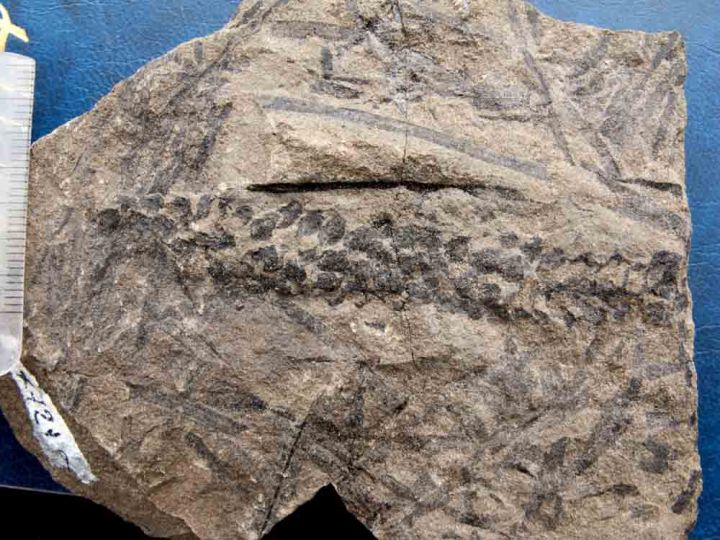In the early 1980s when I was working on the Jurassic fossil forest of Curio Bay, near the bottom end of New Zealand’s South Island, it seemed clear that two main types of tree formed the forest canopy. There were two types of conifer foliage fossil around Curio Bay- one type had the fine, feather-like shoots like today’s matai, and was called Elatocladus. It was probably in the Podocarpaceae family, or some relative, perhaps a distant ancestor. The other had larger leaves, more like a narrow kauri or one of the larger totaras and was called Podozamites. It was probably in the Araucariaceae family. Microscopic analysis of petrified wood from the area also showed two types: Mesembrioxylon and Araucarioxylon. Future research will probably change these names, but they both support Podocarpaceae and Araucariaceae as being the main trees in the forest. There were also two types of cone (or at least cone scales). There were the isolated, wedge-shaped scales, a bit like those of the kauri pine. Thus again supporting Araucariaceae on-site. The second cone was always found intact – it was long and narrow, about the size of a finger (the featured image has a cone where the outside is visible on the left, and a cross-section is visible to the right). It was called Palissya, a genus that had also been found in the Jurassic of Europe. Under each one of its scales there are several attachments – these are where the seeds would have sat. If you had picked up a ripe cone in the Jurassic and ran your finger-nail the wrong way down a cone, several small seeds would have fallen out at each scale – quite distinct from the living Podocarpaceae, which don’t have cones at all.
One of the earlier workers on the New Zealand Jurassic, Edwards, had (in 1934) claimed to have found one of these cone fossils attached to what seemed to be an Elatocladus conifer shoot. Thus Palissya was the cone of the Podocarpaceae trees (perhaps ‘primitive’ ones) of the Curio Bay forest. It all made perfect sense. And as it turns out, probably entirely wrong.
In the early 1990s I took Andrew Drinnan, an Australian paleobotanist, to one of the sites with fossil Palissya not far from Curio Bay – a few kilometers to the west on Slope Point. A paper was subsequently published (Parris et al. 1995) that discussed the New Zealand and Australian examples of Palissya – and expressed doubt that they were from conifers. Some time later I met with Steve McLoughlin, another Australian paleobotanist who said he was fairly sure Palissya was not the cone of a conifer – but of some other seed-forming plant. That really puzzled me, as the biodiversity of the Curio Bay forest was pretty low. We have (or think we have) a reasonable idea what kind of cones/fruits most of the other plants formed. So if Palyssia didn’t grow on conifer trees, what did it grow on?
Fast-forward to last year. A new paper (Pattemore et al. 2014) has looked at the issue again. They concluded that the Australasian Palissya were quite unlike the European ones – and were therefore not Palissya at all. They appear to be either in, or related to, a genus called Knezourocarpon – that was described earlier from the Jurassic of Queensland. As for what plants did produce these cones, Pattemore et al. (2014) suggested “ginkgoalean or pteridospermous affinity”.
The New Zealand ‘Palissya‘ remain a mystery-plant. Surely if the cones are relatively common fossils, the associated foliage must be there as well? There is a very long, narrow leaf, only 2-3 mm wide, that turns up in beds that have ‘Palissya‘. Not sure what to call it yet (there are a bunch of fairly meaningless names that can apply). But this could be the foliage of Palissya. Edwards (1934) said his specimen had “a few linear appressed leaves” on its stalk. Rather than being leaves of Elatocladus, they may be of this other plant. Just a hunch.
References
Edwards, W. N. 1934: Jurassic plants from New Zealand. Annals and Magazine of Natural History, ser. 10, 13: 81–109.
Parris, Kirsten M., Drinnan, Andrew N. and Cantrill, David J. (1995) ‘Palissya cones from the Mesozoic of Australia and New Zealand’, Alcheringa: An Australasian Journal of Palaeontology, 19:2, 87 — 111.
Pattemore, G.A., 2000. A new Early Jurassic pteridosperm fructification from Queensland. J. Afr. Earth Sci. 31 (1), 187–193
Pattemore, G. A., Rigby, J. F. and Playford, G. (2014) Palissya: A global review and reassessment of Eastern Gondwanan material. Review of Palaeobotany and Palynology, 210 50–61.

